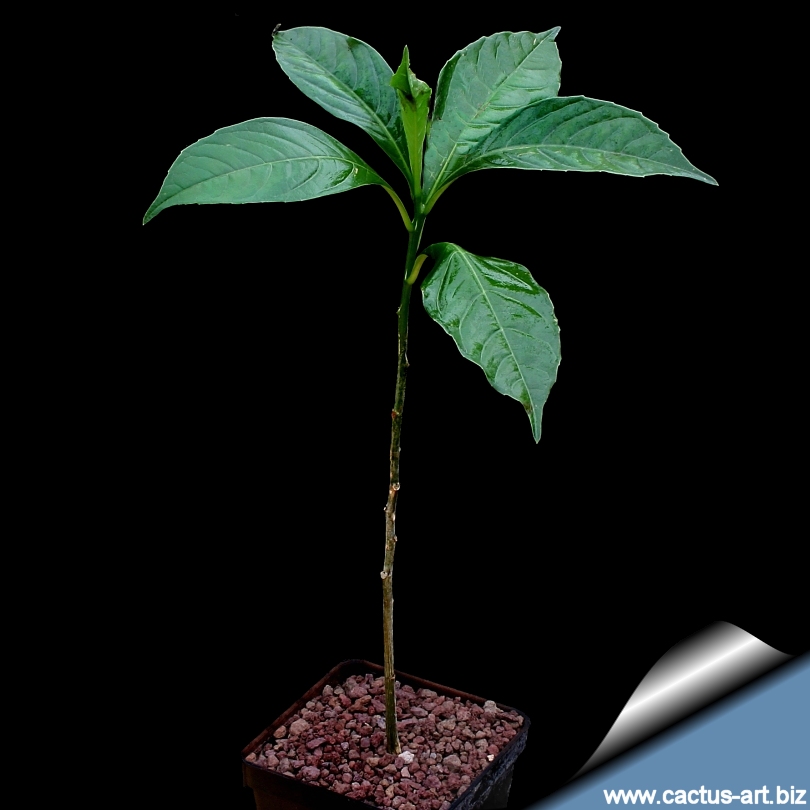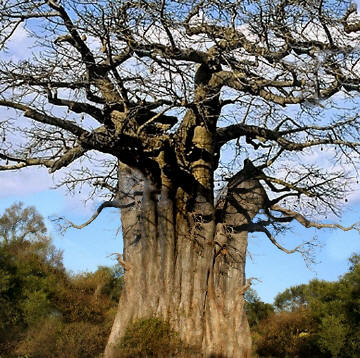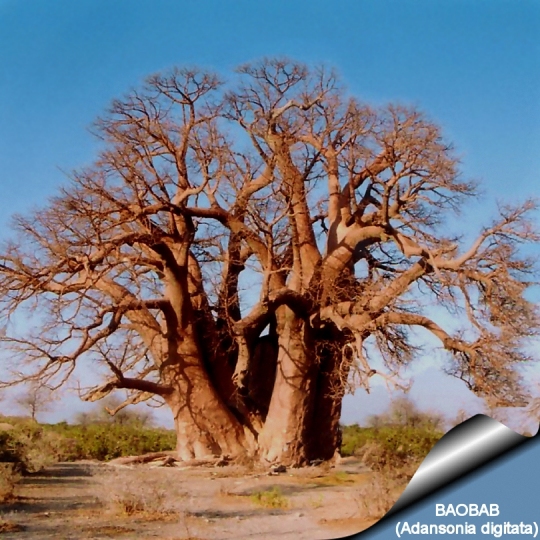|
|
|

A young seedling of Baobab (Adansonia digitata)
When they are young, baobabs do not resemble their
adult counterparts, the stems are thin and inconspicuous, and their
leaves are simple and not divided into the five to seven lobes of the
adult trees. |
|
 |
Description: The African baobab is one of the
plant kingdom's strangest tree, it is not particularly tall growing (up
to 25 m tall and usually less) but the trunk is massive: as much as 11 m
in diameter and shaped like a bottle. It is a deciduous tree, losing its
leaves in the dry season.
Stem: The main stem of larger baobab trees may reach enormous
proportions of up to 28 m in girth usually squat cylindrical trunk gives
rise to thick tapering branches resembling a root-system, which is why
it has often been referred to as the upside-down tree. The trunk is used
to store water during dry periods It's not uncommon for old trees to
have several huge trunks branching off near the ground, and a tree 20
tall can have a spread of more than 30 m. The stem is covered with a
bark layer, which may be 50-100 mm thick. The bark is greyish brown and
normally smooth but can often be variously folded and seamed from years
of growth.
Leaves: Palmately compound and clustered at the ends of short,
stocky branches. They are divided into 5-7 finger-like leaflets. Being
deciduous, the leaves are dropped during the winter months and appear
again in late spring or early summer.
|
Flowers: Large , heavy white and sweetly
scented that hang down on long stalks. The flowers are 10-20 cm across
and have waxy crinkled petals about 10 cm long that surround dense
clusters of purple stamens that look like powder puffs. The flowers open
only at night and are pollinated by bats feeding on the nectar.
Blooming phenology: The baobab blooms At the end of the dry
season. The flowers emerge in the late afternoon from large round buds
on long drooping stalks. The flowers fall within 24 hours, turning brown
and smelling quite unpleasant.
Fruit: Large, pendant egg-shaped capsule (often >30 cm long),
they consists of a hard, woody outer shell velvet covered, gray or
yellowish brown, and apparently look like dead rats hanging from the
tree by their tails. Thy are filled with pulp that dries, hardens, and
falls to pieces which look like chunks of powdery, dry bread. The
off-white, powdery substance is apparently rich in ascorbic acid.
Seed: Hard, dark brown to black, kidney-shaped |
|
Cultivation: Baobabs are quite easily grown from seed although
they are seldom available in nurseries. Grow in good light, don't
over-water and provide a minimum winter temperature of 10-13C as they
cannot tolerate even mild frost. Baobab is very drought tolerant, and
needs no water at all during the winter. Despite its adaptations to dry
climates, baobab will thrive in rainy climates provided it has a well
drained soil provided they are frost free and don't experience cold
winters.
Saplings can be effectively grown in
containers for many years before becoming too large and requiring
to be planted into the ground. In this manner one can move them out of
the cold into a warm position in a glasshouse or indoors behind a sunny
window to prevent frost damage. It can be also trained as a bonsai tree.
|
|
Advertising
|
|
|
|
|
Family: Bombacaceae (Malvaceae) the bombax
or baobab Family |
|
Scientific name: Adansonia
digitata L.
Origin:
Garden origin (Nursery
produced cultivar)
Habitat: It is native to much
of Africa and the most widespread of the Adansonia species, but
restricted to suitable habitats that comprises hot, dry woodland on
stoney, well drained soils, in frost-free areas that receive low
rainfall. It ranges from the dry sub-Saharan scrub to the grassy
savannas/ woodland of South Africa.
It is also widely grown as a street and park tree in the tropics of both
hemispheres.
Ecology: Bats primarily pollinate the large white flowers with
their ruffled petals at night, although many different insects and other
creatures such as birds will visit the sweetly scented flowers.
Conservation status: Not threatened
Common Names include: baobab, dead-rat tree, bottle tree,
monkey-bread tree baobab, Cream of Tartar tree, monkey-bread tree,
lemonade tree (Eng.);
Etymology: Adansonia: Named
after a French surgeon Michel Adanson (1727-1806). digitata:
hand-shaped, referring to the shape of the leaves.
Common Names:
|
|

The baobab tree is regarded as being the largest tree
in Africa and the largest succulent plant in the world,
it is leafless for nine months of the year.
|
|
|
|
In the wet months water is stored
in its thick, corky, fire-resistant trunk for the nine dry months ahead.
Some large individuals live to well over a thousand years of age.
However the age of a large large baobabs cannot be reliably established
using tree rings. Carbon dating has shown that a 7 m diameter tree is
about 600 years old, so a large tree is probably over 1000 years old.
This age is a lot less than some previous estimates that have been
placed at over 5000 years old. The baobab is just as beautiful in winter
after the leaves have dropped and the tree's grandly grotesque form can
be seen and enjoyed. The baobab tree is steeped in a wealth of mystique,
legend and superstition wherever it occurs in Africa. It is a tree that
can provide, food, water, shelter and relief from sickness.
Uses: The baobab's bark, leaves, fruit, and trunk are all used.
The bark of the baobab is used for cloth and rope, the leaves for
condiments and medicines, while the fruit, called "monkey bread", is
eaten. Sometimes people live inside of the huge trunks.
|
|
Reproduction: The seeds
should be soaked in a container of hot water and allowed to cool, they
may then be sown after soaking for 24 hrs. Sow in trays, pots, etc o in
a well-drained seedling mixture containing one-third sand in a
propagator or warm place to maintain an optimum temperature of 25-27C.
Sowing Depth: 1.5 mm. Seeds are best sown in spring and summer .
Germination may take from two to six weeks. Baobabs grow reasonably
quickly when they are young. It also can be started from cuttings.

 |
|